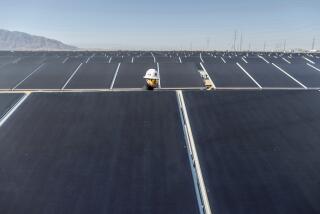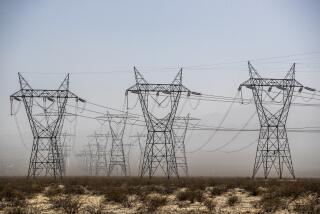Is T. Boone Pickens right?
Today’s question: Oil giant T. Boone Pickens wants to turn much of the Great Plains into a wind-power farm. How practical is his plan? Should we do it? Previously, White and Taylor discussed offshore drilling.
Half right is a good place to start
Point: V. John White
Legendary oil man T. Boone Pickens is an unlikely green-energy hero. But his plan to radically expand wind energy production and shift natural gas from electricity production to fueling cars and trucks has caught the public’s imagination.
Pickens is planning to build the world’s largest wind farm in Texas, and he has taken options on wind turbines without waiting for Congress to extend federal tax credits. He has launched a multimillion-dollar media blitz and has appeared on television news shows touting the domestic energy potential of large-scale wind farms and natural-gas vehicles. Pickens has created a buzz because he has a plan at a time when our nation’s leaders are paralyzed with indecision and inaction.
The wind power part of Pickens’ plan makes a lot of sense. There is enormous potential for wind energy throughout the U.S., with tens of thousands of megawatts of power that can be generated in the Upper Midwest, Great Plains, the Rocky Mountain West and Texas. In California, the Tehachapi region of Kern County has the potential to add two or three nuclear plants’ worth of wind energy to the California grid. The U.S. Department of Energy recently endorsed a plan to make the nation’s electricity portfolio 20% wind by 2020.
The kind of large scale expansion of wind energy that Pickens is talking about would yield billions of dollars’ worth of economic development, create thousands of jobs and bring more income to farmers who lease their land to their new wind energy partners.
Getting this wind power to urban load centers will require significant investment in new and expanded electric transmission lines. Building such infrastructure is often controversial, and transmission lines take years to get approved and built. Texas, Minnesota and Colorado have recently approved large scale expansion of their transmission grid to bring wind power to the urban centers, and the Western Governors’ Assn. has just begun a renewable power and transmission planning effort to support 30,000 megawatts of wind, solar and geothermal power. Pickens has urged us to think big about wind and to get to work doing it, and he’s right.
The second part of the Pickens plan, to shift natural gas from electric power production to transportation fuel, makes less sense. He touts natural gas as an abundant domestic fuel and says using it in cars and trucks could displace large amounts of imported oil. But the price of natural gas has tripled in the last five years, and domestic production has been flat until high prices recently spurred expanded production. Many experts believe that U.S. natural gas production could peak soon, and in the future, the U.S. will import large amounts of liquefied natural gas from Russia, Indonesia and the Middle East.
Using natural gas in high efficiency combined-cycle power plants is a very good use of this precious energy resource. Because we can’t be sure current levels of domestic natural gas production can be sustained, efficiency matters a lot. Competition from natural gas vehicles has helped make diesel engines far cleaner than we imagined they could be. But natural gas vehicles require expensive investments in infrastructure, and the emissions advantages over diesel have narrowed.
Rapidly accelerating the mass development of plug-in hybrid vehicles and other uses of electricity for transportation makes more sense in the long run. Plug-in hybrids can be charged at night, when using electricity is less expensive. Charging plug-ins and, some day, making hydrogen for fuel cells from wind energy that blows at night is a good way to make efficient use of our electricity system -- and makes more sense than building a whole new infrastructure for natural gas vehicles.
But Pickens deserves credit for being half right and getting us all to think big about wind energy.
V. John White is executive director of the Sacramento-based Center for Energy Efficiency and Renewable Technologies.
Pickens’ plan to rig the market
Counterpoint: Jerry Taylor
John, the Pickens plan is nothing more than a call to rig the market to direct private dollars toward the fuels that Pickens has invested in and away from the fuels that Mr. Pickens has not invested in. Gee, what a visionary.
The market needs to be rigged because the fuels that Pickens champions -- wind power and compressed natural gas (CNG) -- would otherwise get little attention from energy producers. Doubt me, John? Ask the trade association representing wind energy or CNG what happens to their market share were the corporate welfare directed at their industries to disappear.
John, your claim that Pickens’ wind energy ideas “make a lot of sense” is correct only if your last name happens to be Pickens. Wind energy is a dubious investment for a number of reasons. First, absent subsidies, it’s nearly twice as expensive to produce as coal-fired electricity, and the subsidies on the books, although lavish, have not managed to close that cost gap. Second, wind turbines produce most of their electricity during off-peak hours, when wholesale electricity prices are lowest, and very little electricity during hot summer days, when wholesale electricity prices are highest. Third, because wind speed is variable, wind energy production is variable, and undependable dispatch usually forces wind producers to operate or contract for back-up fossil fuel electricity generation to meet commitments to the grid when their wind facilities cannot. Fourth and finally, because wind energy can only be profitably sited in places where consumers generally are not, the cost of getting that electricity to ratepayers is far higher than it is for conventional power plants, which likewise adds substantially to cost. All of that largely explains why wind energy today only supplies two-thirds of 1% of the electricity market.
Compressed natural gas is relatively more attractive, yet employing it in large quantities in the transportation sector requires all-new vehicles or costly retrofits of existing vehicles and an entirely new fuel delivery infrastructure. Hence, the transition costs aren’t cheap. While natural gas is currently cheaper than conventional gasoline, how long this might be true is unclear, particularly if we assume a massive increase in natural gas demand for motor fuels use. Energy economist A.F. Alhajji calculates that even if all natural gas consumption today were dedicated toward automotive transportation, only 65% of our motor needs would be met.
If either wind or CNG has economic merit, then no market rigging would be necessary; the promise of future profit would be enough to provide all the money necessary to jump-start those industries. If neither wind nor CNG has economic merit, then no amount of market rigging will bestow it. All it will do is take money from relatively more worthy investments.
Economists of virtually all stripes would concede that, as a general matter, leaving the decisions about what to produce to producers and what to consume to consumers will produce more efficient economic outcomes than leaving those decisions to government planners or would-be central planners like Pickens. And that’s doubly true because market actors make decisions (however flawed) based on economic merit, whereas governmental agents invariably make decisions based on political merit. Only by the sheerest of chance will politically attractive ideas also prove to be economically attractive ideas.
That’s the main reason why even Carl Pope, the executive director of the Sierra Club, agrees with me that the best energy plan is to remove everyone’s subsidies and regulatory preferences and let the best fuel win. Unfortunately, the Pickens plan goes in the opposite direction.
If the idea is to promote more environmentally friendly energy or energy from domestic sources, then the most direct and least costly means of doing so is to impose a tax on pollution equal to the damages caused by that pollution, or a tax on foreign oil equal to the alleged social costs of the same and let markets sort out what to do. While I don’t support such taxes because I’m not convinced that there are significant costs associated with either electricity generation or energy imports, those who are so convinced have better places to shop than Pickens’ website for good public policy.
Jerry Taylor is a senior fellow at the Cato Institute.
| Day 2 | | |
More to Read
A cure for the common opinion
Get thought-provoking perspectives with our weekly newsletter.
You may occasionally receive promotional content from the Los Angeles Times.






